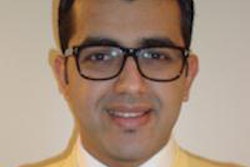
Pakistan is facing a shortage of radiology faculty members as they are leaving the country for more lucrative salaries and better working conditions abroad, according to a new article in the Journal of the American College of Radiology.
Author Dr. Vaqar Bari from the Aga Khan University Hospital radiology department explained that the radiologist brain drain has reached an alarming rate in recent years.
"This has been going on steadily for a long time, but the intensity has increased recently because of the deteriorating law and order situation, especially in Karachi," he told AuntMinnieEurope.com. "Also, economic reasons play a big role and a lot of faculty members leave to secure their financial future."
The government has taken some measures to curb this trend, increasing salaries for radiology faculty from around 50,000 rupees (approximately 350 euros) to 100,000 rupees (approximately 700 euros) per month. Private institutions, in an attempt to keep pace, have increased salaries from about 100,500 rupees to 200,000 rupees, but these are still not adequate salaries for someone who can make much more than that amount abroad, Bari explained.
He gave the example of neighboring India, where a substantial increase in salaries has attracted many trained doctors to return to the country. And while this is a good trend for India, it has indirectly exacerbated the problem for Pakistan.
"As a lot of trained Indian doctors return to India, there is a void left behind that is being filled by Pakistanis," he said. "The Middle East has attractive salaries to offer, and while they had 10 open positions before they now have 20."
Apart from the Middle East, other favored destinations are Europe and North America. Those who move to the Middle East eventually have to return since most Middle Eastern countries do not offer permanent residency, but those who move to Europe and North American tend to settle there permanently, Bari wrote (JACR, October 2013, Vol. 10:10, pp. 795-799).
As faculty members leave, those left behind become overworked and discouraged, and this may create a vicious cycle of departures and discontent, he noted. The shortage also puts pressure on remaining radiologists to complete clinical work while research and education are neglected and the department becomes unattractive to candidates with strong academic commitments.
What's behind the brain drain?
According to Bari, apart from the problem of inadequate compensation, other reasons for the decline include a better law and order situation abroad, improved working conditions and benefits, relief from the pressure to publish or conduct research, opportunity for advanced training, and a more fair system of promotions.
Bari laid out some key strategies to retain radiology faculty in Pakistan and suggested that these be implemented without delay.
In his JACR paper, he recommends better working hours, call frequency, and vacation time, and he noted that an increased workload because of staff shortage is often acceptable if financial compensation is adjusted accordingly. Salaries and benefits must be improved, and radiologists may even be allowed to pursue private practice positions within the university setting.
Bari pointed out that it's important to reduce the income disparity between academic radiologists and those in private practice. He also advocates for more defined promotion policies to reduce discontent, as well as the implementation of two distinct faculty tracks: clinical educator and clinical researcher.
He noted that staff shortages can be addressed with the involvement of medical professionals such as cardiologists and other nonradiologists performing imaging procedures related to their specialties, and also through the use of radiologist assistants. Recruitment of part-time radiologists, especially female radiologists who often prefer flexible hours, and an increase in the number of residents can also alleviate the situation.
Bari explained that radiology residency is a four- to five-year program in Pakistan, and fifth-year residents can perform duties similar to junior faculty members. His other suggestions included implementing faculty development programs, shifting to paperless departments, improving workflow by adopting modern technology, utilizing teleradiology, and involving residents in teaching.
Last resorts?
He also offered two solutions which he believes should only be considered as last resorts. Some programs can be merged or cut entirely if there is a faculty shortage, he wrote, and outsourcing can be used as an interim arrangement to ease the burden on existing faculty.
Bari told AuntMinnieEurope.com that some of the strategies he has suggested are already being implemented. For example, there is a trend toward using more technologists and an increased involvement of residents in teaching.
"In most countries, ultrasounds are not done by radiologists but by technologists, but in Pakistan people insist that a radiologist perform the ultrasound," he said. "However, there is a move toward involving more technologists now."
He also pointed out that while some measures can be taken by institutions, other issues fueling the problem, such as law and order and terrorism, are completely out of their control.
Some of his suggested solutions are cost-intensive, but he explained that the strategy to implement these measures is to tell the relevant authorities that the benefits to the institution will outweigh the costs.
"This includes higher revenue generation, improved and efficient services to the recipients of healthcare, the ability to expand services, and the introduction of new services resulting in satisfied patients and contented faculty members," he concluded.



















